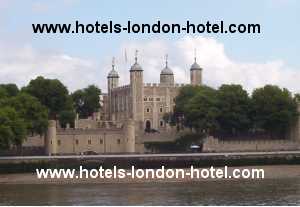Tower of London
 |
The Present Tower of London is the world's biggest manned castle still used as a fortification (Windsor castle is the worlds biggest castle used as a residence).
The Tower still belongs to H M the Queen and is still classed as a royal palace.
The keep also known as the White Tower, because it was covered with white lime (the building in the heart of the tower complex) was built by William 1st not long after the battle of Hastings (1066) in order to keep his new kingdom and capital city under control. It was built on the site of a previous Roman fortress inside the remains of the Roman City wall. The Stone keep was itself an innovation it is 90 feet high and the walls are between 11 and 15 feet thick. It was built as a royal residence and as the seat of visible power.
In the reign of Richard 1st the castle was extended and a moat added it became England's largest concentric fortress (two rings of defence).
Various monarchs added and extended the Tower over the centuries though after the fourteenth century most additions tended to be inside the tower itself.
It has been over the centuries a Royal residence, a prison, a fortress, and a zoo and even housed the Royal mint where coins were made right up till 1830.
The tower has many fascinating places to see and experience first hand. The White tower holds the almost untouched and perfect Norman chapel St John the evangelist, the bloody tower is where the princes in the Tower, nephews of Richard 3rd were murdered, Tower green itself has born witness to many executions over the years perhaps the most famous being Ann Bolyne the second wife of Henry 8th, here too lady Jane Grey the nine days queen was executed on the orders of Mary 1st (bloody Mary) in 1554, in 1618 Sir Walter Raleigh was beheaded on the orders of James 1st for failing to find El Dorado in the new world. The block itself is a replica, the real one thankfully having rotted away through disuse.
The victims of the axeman being buried in the medieval church of St Peter ad vincula (St Peter in chains) next to Tower Green.
The Tower was also the site of a private royal zoo in medieval times, the animals forming the core of what became London Zoo; it also housed the first Royal observatory. Tower Hill, just outside the walls, the area by the entrance was where important political prisoners were executed to the delight and entertainment of the crowd well into the eighteenth century.
The Beauchamp and St Thomas towers are worth seeing. Of course no trip to the Tower of London is complete without seeing Traitors gate, the river entrance to the fortress, here prisoners of note were brought down the Thames often as a prelude to their execution. During the reign of Bloody Mary the future Elizabeth 1st was brought here as a prisoner suspected of plotting against her sister. She refused to enter the Tower insisting upon her innocence (it was a severe downpour of rain, which persuaded her to enter) it was that protest which probably saved her from the fate of her cousin Lady Jane Grey.
Other famous guests included Thomas More, Catherine Howard, Thomas Cromwell, also the Bishops Fisher and Cranmer, in more recent years the Tower housed Rudolf Hess. It was the imprisonment of the seven Bishops in the Tower during the reign of James 2nd that triggered the Glorious Revolution of 1688 and the invitation to William of Orange to become King.
The Tower houses part of the Royal Armouries collection, probably the world's greatest collection of armour and armaments; it also houses the magnificent Crown Jewels in the new Jewel house. (They were at one point housed in St Martins tower; here in 1671 Colonel Blood almost succeeded in stealing the St Edwards crown the orb and the sceptre posing as a clergyman).
The Crowns Jewels are the finest in the world. The Sceptre holds the largest diamond, the Cullinnan diamond. The St Edwards Crown holds the St Edward confessor sapphire and also the Black Prince Ruby and not to be missed is the Koh in noor Diamond in the crown made for the coronation of the late Queen Elizabeth the Queen mother in 1937.
Also worth looking out for are the Beefeaters or to be correct H. M. Yeoman Warders originally an elite bodyguard for the monarch, begun by Henry 7th (1485-1509). The Yeomen are not the only permanent residents either, try to get a peek at the ravens who have their wings clipped so that they may not leave the Tower. (Legend has it that if the Ravens leave then the kingdom will fall.)
The Tower was begun as a fortress to subdue the city it has now become the epicentre of English history.
|

